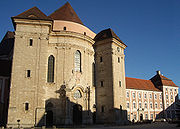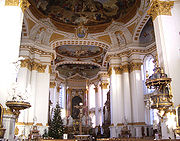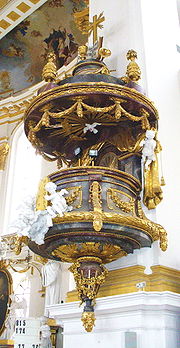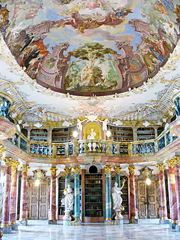
Wiblingen Abbey
Encyclopedia






Benedictine
Benedictine refers to the spirituality and consecrated life in accordance with the Rule of St Benedict, written by Benedict of Nursia in the sixth century for the cenobitic communities he founded in central Italy. The most notable of these is Monte Cassino, the first monastery founded by Benedict...
abbey
Abbey
An abbey is a Catholic monastery or convent, under the authority of an Abbot or an Abbess, who serves as the spiritual father or mother of the community.The term can also refer to an establishment which has long ceased to function as an abbey,...
which was later used as barracks. Today its buildings house several departments of the medical faculty of the University of Ulm
University of Ulm
The University of Ulm is a public university in the city of Ulm, in the South German state of Baden-Württemberg. The university was founded in 1967 and focuses on natural sciences, medicine, engineering sciences, mathematics, economics and computer science...
. The former abbey is located south of the confluence
Confluence (geography)
In geography, a confluence is the meeting of two or more bodies of water. It usually refers to the point where two streams flow together, merging into a single stream...
of the rivers Danube
Danube
The Danube is a river in the Central Europe and the Europe's second longest river after the Volga. It is classified as an international waterway....
and Iller
Iller
The Iller is a river in Bavaria, Germany. It is a right tributary of the Danube, 147 km in length.The source is located near Oberstdorf in the Allgäu region of the Alps, close to the Austrian border. From there it runs northwards, passing the towns of Sonthofen, Immenstadt, and Kempten...
, south of the city of Ulm
Ulm
Ulm is a city in the federal German state of Baden-Württemberg, situated on the River Danube. The city, whose population is estimated at 120,000 , forms an urban district of its own and is the administrative seat of the Alb-Donau district. Ulm, founded around 850, is rich in history and...
in the German
Germany
Germany , officially the Federal Republic of Germany , is a federal parliamentary republic in Europe. The country consists of 16 states while the capital and largest city is Berlin. Germany covers an area of 357,021 km2 and has a largely temperate seasonal climate...
state
States of Germany
Germany is made up of sixteen which are partly sovereign constituent states of the Federal Republic of Germany. Land literally translates as "country", and constitutionally speaking, they are constituent countries...
of Baden-Württemberg
Baden-Württemberg
Baden-Württemberg is one of the 16 states of Germany. Baden-Württemberg is in the southwestern part of the country to the east of the Upper Rhine, and is the third largest in both area and population of Germany's sixteen states, with an area of and 10.7 million inhabitants...
. Administratively, the former independent village of Wiblingen now belongs to the city of Ulm. The abbey is part of the Upper Swabian Baroque Route
Upper Swabian Baroque Route
The Upper Swabian Baroque Route is a touristic theme route through Upper Swabia, following the themes of "nature, culture, baroque". The route has a length of about 500 km . It was established in 1966, being one of the first theme routes in Germany...
.
From the foundation to 1701
Wiblingen Abbey was founded in 1093 by the counts Hartmann and Otto von Kirchberg.The counts offered monk
Monk
A monk is a person who practices religious asceticism, living either alone or with any number of monks, while always maintaining some degree of physical separation from those not sharing the same purpose...
s of St. Blaise's Abbey in the Black Forest
St. Blaise's Abbey in the Black Forest
Sankt Blaise's Abbey in the Black Forest was a Benedictine monastery in the village of St. Blasien in the Black Forest in Baden-Württemberg, Germany.- 9th–12th centuries :The early history of the abbey is obscure...
lands near the river Iller, which the monks used to found a filial institution. In 1099, the first buildings were consecrated. The first abbot
Abbot
The word abbot, meaning father, is a title given to the head of a monastery in various traditions, including Christianity. The office may also be given as an honorary title to a clergyman who is not actually the head of a monastery...
was Werner von Ellerbach. In the same year, the founding counts offered the abbey a splinter of the Holy Cross
True Cross
The True Cross is the name for physical remnants which, by a Christian tradition, are believed to be from the cross upon which Jesus was crucified.According to post-Nicene historians, Socrates Scholasticus and others, the Empress Helena The True Cross is the name for physical remnants which, by a...
which they had acquired during their participation in the First Crusade
First Crusade
The First Crusade was a military expedition by Western Christianity to regain the Holy Lands taken in the Muslim conquest of the Levant, ultimately resulting in the recapture of Jerusalem...
.
During the High
High Middle Ages
The High Middle Ages was the period of European history around the 11th, 12th, and 13th centuries . The High Middle Ages were preceded by the Early Middle Ages and followed by the Late Middle Ages, which by convention end around 1500....
and the Late Middle Ages
Late Middle Ages
The Late Middle Ages was the period of European history generally comprising the 14th to the 16th century . The Late Middle Ages followed the High Middle Ages and preceded the onset of the early modern era ....
Wiblingen Abbey was famous for its scholarship and learning as well as being a place of exemplary monastic discipline due its strict adherence to the rule of St. Benedict
Benedict of Nursia
Saint Benedict of Nursia is a Christian saint, honored by the Roman Catholic Church as the patron saint of Europe and students.Benedict founded twelve communities for monks at Subiaco, about to the east of Rome, before moving to Monte Cassino in the mountains of southern Italy. There is no...
.
During the Thirty Years' War
Thirty Years' War
The Thirty Years' War was fought primarily in what is now Germany, and at various points involved most countries in Europe. It was one of the most destructive conflicts in European history....
the abbey suffered repeatedly from warfare. On the initiative of Abbot Johannes Schlegel the Holy-Cross-Relic was hidden in order to protect it from marauding Protestant
Protestantism
Protestantism is one of the three major groupings within Christianity. It is a movement that began in Germany in the early 16th century as a reaction against medieval Roman Catholic doctrines and practices, especially in regards to salvation, justification, and ecclesiology.The doctrines of the...
Swedish troops. However, following the withdrawal of the Swedish troops the relic could not be recovered, since there was no one alive who remembered its hiding place, the witnesses to its concealment all having succumbed to the plague
Bubonic plague
Plague is a deadly infectious disease that is caused by the enterobacteria Yersinia pestis, named after the French-Swiss bacteriologist Alexandre Yersin. Primarily carried by rodents and spread to humans via fleas, the disease is notorious throughout history, due to the unrivaled scale of death...
. Only years later, the immured relic was rediscovered.
Due to the efforts of Abbot Benedict Rauh, whose term in office lasted from 1635 to 1663 and who also functioned as military bishop to the Bavarian
History of Bavaria
The history of Bavaria stretches from its earliest settlement and its formation as a stem duchy in the 6th century through its inclusion in the Holy Roman Empires to its status as an independent kingdom and, finally, as a large and significant Bundesland of the modern Federal Republic of...
army, the abbey managed to survive the calamities of the war. He is also responsible for instigating the abbey's economic recovery after 1648. The increasing economic and political importance under abbots Ernest Fabri, Maurus Falkner and Modest I led to the abbey being granted the status of Imperial immediacy
Reichsfreiheit
Imperial immediacy was a privileged feudal and political status, which the estates of the realm such as an imperial city, a religious entity, a feudal principality, or a minor lordship could attain within the Holy Roman Empire...
in 1701.
1701–1806 — Renewal of the abbey
The status of the abbey as an independent territory within Further AustriaFurther Austria
Further Austria or Anterior Austria was the collective name for the old possessions of the House of Habsburg in the former Swabian stem duchy of south-western Germany, including territories in the Alsace region west of the Rhine and in Vorarlberg, after the focus of the Habsburgs had moved to the...
seems to have brought about the renewal of the abbey buildings, a process that started in 1714. Most buildings were erected in Late-Baroque
Baroque
The Baroque is a period and the style that used exaggerated motion and clear, easily interpreted detail to produce drama, tension, exuberance, and grandeur in sculpture, painting, literature, dance, and music...
-style with the exception of the church, which was to become one of the main examples of Early-Neo-classicism in Southern Germany. The structures of the medieval abbey had been continuously enlarged and changed during the previous centuries with the originally church having been built in the style of Romanesque architecture
Romanesque architecture
Romanesque architecture is an architectural style of Medieval Europe characterised by semi-circular arches. There is no consensus for the beginning date of the Romanesque architecture, with proposals ranging from the 6th to the 10th century. It developed in the 12th century into the Gothic style,...
.
When the Wiblingen Abbey achieved the status of Imperial immediacy, an extensive plans for a rebuilding of the abbey, based on El Escorial
El Escorial
The Royal Seat of San Lorenzo de El Escorial is a historical residence of the king of Spain, in the town of San Lorenzo de El Escorial, about 45 kilometres northwest of the capital, Madrid, in Spain. It is one of the Spanish royal sites and functions as a monastery, royal palace, museum, and...
in Spain
Spain
Spain , officially the Kingdom of Spain languages]] under the European Charter for Regional or Minority Languages. In each of these, Spain's official name is as follows:;;;;;;), is a country and member state of the European Union located in southwestern Europe on the Iberian Peninsula...
, were made with the abbey church in its centre surrounded by a symmetrical quarters and courtyards. The plans were drafted by Baroque-architect
Architect
An architect is a person trained in the planning, design and oversight of the construction of buildings. To practice architecture means to offer or render services in connection with the design and construction of a building, or group of buildings and the space within the site surrounding the...
Christian Wiedemann. Works began with the building of the courtyards whose design was influenced by the plans for Einsiedeln Abbey
Einsiedeln Abbey
Einsiedeln Abbey is a Benedictine monastery in the town of Einsiedeln in the Canton of Schwyz, Switzerland. The abbey is dedicated to Our Lady of the Hermits, the title being derived from the circumstances of its foundation, from which the name Einsiedeln is also said to have originated...
by architect Caspar Moosbruger. However, in 1730 the original design was altered with as a consequence that the gate house and the church were not on one axis any longer. More changes to the original design were made: the originally planned central building was replaced by an elongated structure, probably influenced by the design of Weingarten Abbey
Weingarten Abbey
Weingarten Abbey or St. Martin's Abbey is a Benedictine monastery on the Martinsberg in Weingarten near Ravensburg in Baden-Württemberg .-First foundation:...
and plans by Caspar Moosbruger.
Following Wiedemann's design, the famous library was built in the North wing of the abbey. At the time of completion in 1744, the works were already supervised by Christian Wiedemann's nephew Johann Wiedemann. In 1750, a new superintendent
Superintendent (construction)
On larger projects, it is common for most finance-related tasks and long-term scheduling to be handled by a project manager, with the superintendent's job limited to running the day-to-day operations on the construction site and controlling the short-term schedule...
, Johann Michael Fischer
Johann Michael Fischer
Johann Michael Fischer was a German architect in the late Baroque period....
, was appointed. He revised the original plans by Wiedemann. His main achievement is the new design for the East wing which was given a conspicuous risalit
Risalit
A risalit, from the Italian risalto for "projection", is a German term which refers to a part of a building that juts out, usually over the full height of the building. In English the French term avant-corps is sometimes used. It is common in façades in the baroque period.A corner risalit is where...
thereby emphasizing on the one hand the role of the chapter house
Chapter house
A chapter house or chapterhouse is a building or room attached to a cathedral or collegiate church in which meetings are held. They can also be found in medieval monasteries....
as the centre of the monastic organisation and the fact that it was also the centre of a semi-sovereign territorial unit of power. The facade of this building was modelled on the Imperial Court Library in Vienna
Vienna
Vienna is the capital and largest city of the Republic of Austria and one of the nine states of Austria. Vienna is Austria's primary city, with a population of about 1.723 million , and is by far the largest city in Austria, as well as its cultural, economic, and political centre...
which was chosen in order to demonstrate the abbey's attachment to the imperial house.
Fischer's contribution to the design of the abbey church are still controversial. The original drafts cannot be attributed to Fischer directly due their containing numerous errors and inaccuracies which implies that the existing drafts were inspired by Fischer but not drawn by him. The sketches must have been drawn by one of his successors after Fischer's departure in 1757. It is possible that the sketches were made either by Johann Wiedemann or his son Dominikus Wiedemann who worked with Balthasar Neumann
Balthasar Neumann
Johann Balthasar Neumann , also known as Balthasar Neumann, was a [German] military artillery engineer and architect who developed a refined brand of Baroque architecture, fusing Austrian, Bohemian, Italian, and French elements to design some of the most impressive buildings of the period,...
at Neresheim Abbey
Neresheim Abbey
Neresheim Abbey or the Abbey of Saints Ulrich and Afra, Neresheim is located above the town of Neresheim in Baden-Württemberg, southern Germany...
from where the drafts were later moved to the central archive of the Princes of Thurn und Taxis
Thurn und Taxis
The Princely House of Thurn and Taxis is a German family that was a key player in the postal services in Europe in the 16th century and is well known as owners of breweries and builders of many castles.- History :...
in Regensburg
Regensburg
Regensburg is a city in Bavaria, Germany, located at the confluence of the Danube and Regen rivers, at the northernmost bend in the Danube. To the east lies the Bavarian Forest. Regensburg is the capital of the Bavarian administrative region Upper Palatinate...
.
Due to financial strains the building of the church had not even started at the time of the death of Abbot Meinrad Hamberger (1730–1762). His successor, Modest II (1762–1768), either showed no interest in continuing the building works or was suffering from lack of revenue to complete them. Only during the term of Abbot Roman Fehr (1768–1798) the foundation of the church was laid. His superintendent was Johann Georg Specht
Johann Georg Specht
Johann Georg Specht was born in Lindenberg im Allgäu. He was a civil engineer and architect in the south of Germany.Johann Georg Specht trained as a civil engineer with Peter Thumb in Vorarlberg....
, who had intimate knowledge of the erection of the church at the Abbey of St. Gall
Abbey of St. Gall
The Abbey of Saint Gall is a religious complex in the city of St. Gallen in present-day Switzerland. The Carolingian-era Abbey has existed since 719 and became an independent principality during the 13th century, and was for many centuries one of the chief Benedictine abbeys in Europe. It was...
and of the Pilgrimage Church Birnau. He planned his building in Wiblingen according to these examples which would have resulted in the church having a Late-Baroque appearance. However, he could not further his design since he was pushed aside by the fresco
Fresco
Fresco is any of several related mural painting types, executed on plaster on walls or ceilings. The word fresco comes from the Greek word affresca which derives from the Latin word for "fresh". Frescoes first developed in the ancient world and continued to be popular through the Renaissance...
painter Januarius Zick
Januarius Zick
Johann Rasso Januarius Zick was a painter and architect. He is considered to be one of the main masters of the Late-Baroque.-Life:...
, who had been educated to become an architect by Jakob Emele at Schussenried Abbey
Schussenried Abbey
Schussenried Abbey was a Premonstratensian monastery in Bad Schussenried, Upper Swabia, Baden-Württemberg, Germany.- History :...
. Zick managed to finish the church in the so-called Greek-style, a term designating very early Neo-classicist buildings. He succeeded in doing so particularly in the interior where there is a balance between early Neo-classicism and a reminiscence of late Baroque. The facade remained incomplete even though the last abbot, Ulrich IV, tried in vain to have it finished during the Napoleonic Wars
Napoleonic Wars
The Napoleonic Wars were a series of wars declared against Napoleon's French Empire by opposing coalitions that ran from 1803 to 1815. As a continuation of the wars sparked by the French Revolution of 1789, they revolutionised European armies and played out on an unprecedented scale, mainly due to...
. The South wing remained unfinished too until 1917.
Secularisation
After Austria's defeat during the War of the Third Coalition in 1805, the abbey was first occupied by troops of the Grand Duchy of BadenHistory of Baden
The history of Baden as a state began in the 12th century, as a fief of the Holy Roman Empire. A fairly inconsequential margraviate that was divided between various branches of its ruling family for much of its history, it gained both status and territory during the Napoleonic era, when it was...
and then by Bavarian troops. In 1806, the abbey became property of the newly founded Kingdom of Württemberg
History of Württemberg
Württemberg developed as a political entity in south-west Germany, with the core established around Stuttgart by Count Conrad . His descendants managed to expand Württemberg, surviving Germany's religious wars, changes in imperial policy, and invasions from France. The state had a basic...
whereupon the Bavarian troops left after they had auctioned off all the remaining furniture. Wiblingen Abbey was one of the last monasteries to be dissolved during the mediatisation
German Mediatisation
The German Mediatisation was the series of mediatisations and secularisations that occurred in Germany between 1795 and 1814, during the latter part of the era of the French Revolution and then the Napoleonic Era....
of ecclesiastical states and territories. The monks moved to Tyniec Abbey
Tyniec
Tyniec is a historic village in Poland on the Vistula river, since 1973 a part of the city of Kraków . Tyniec is notable for its famous Benedictine abbey founded by king Casimir the Restorer in 1044.-See also:...
, now part of the Polish city of Kraków
Kraków
Kraków also Krakow, or Cracow , is the second largest and one of the oldest cities in Poland. Situated on the Vistula River in the Lesser Poland region, the city dates back to the 7th century. Kraków has traditionally been one of the leading centres of Polish academic, cultural, and artistic life...
. Wiblingen Abbey became a residence for Duke Henry Heinrich, brother of Frederick I of Württemberg
Frederick I of Württemberg
Frederick I William Charles of Württemberg was the first King of Württemberg. He was known for his size: at and about , he was in contrast to Napoleon, who recognized him as King of Württemberg.-Biography:...
.
In the 1840s, the former abbey became part of the Federal Fortress Ulm and was used, since 1848, as infantry barracks
Barracks
Barracks are specialised buildings for permanent military accommodation; the word may apply to separate housing blocks or to complete complexes. Their main object is to separate soldiers from the civilian population and reinforce discipline, training and esprit de corps. They were sometimes called...
. Only then, the convent building surrounding the abbey church was finished. Those buildings which had originally not been able to be completed were erected between 1915 and 1917 by using old drafts. Until the end of World War II
World War II
World War II, or the Second World War , was a global conflict lasting from 1939 to 1945, involving most of the world's nations—including all of the great powers—eventually forming two opposing military alliances: the Allies and the Axis...
the former abbey was used as barracks. After the war the buildings housed refugees.
Today
Wiblingen is part of the Upper Swabian baroque Route. The abbey church and the abbey library in the North wing of the abbey are open to the public. Guided tours are available. The abbey museum, opened in 2006, is located in the former guest rooms of the convent.The abbey church St. Martin is used as a Catholic parish church and was elevated to the status of basilica minor by Pope John Paul II
Pope John Paul II
Blessed Pope John Paul II , born Karol Józef Wojtyła , reigned as Pope of the Catholic Church and Sovereign of Vatican City from 16 October 1978 until his death on 2 April 2005, at of age. His was the second-longest documented pontificate, which lasted ; only Pope Pius IX ...
in 1993.
The rest of the North wing and the adjoining former commercial buildings are now part of the University of Ulm
University of Ulm
The University of Ulm is a public university in the city of Ulm, in the South German state of Baden-Württemberg. The university was founded in 1967 and focuses on natural sciences, medicine, engineering sciences, mathematics, economics and computer science...
, housing the School for Medical Documentation.
The South wing of the abbey, having been rebuilt in 1917, is part of the local network of municipal retirement home
Retirement home
A retirement home is a multi-residence housing facility intended for senior citizens. Typically each person or couple in the home has an apartment-style room or suite of rooms. Additional facilities are provided within the building, including facilities for meals, gathering, recreation, and some...
s.
Further reading
- Beck, O. (1997). Einstige Kloster- und heutige Pfarrkirche Sankt Martinus in Wiblingen. Päpstliche Basilika. Lindenberg: Kunstverlag Fink. ISBN 3-931820-55-6
- Bölz G. (1922). Die Baugeschichte des Klosters Wiblingen. Stuttgart: Technische Hochschule, diss.
- Braig M. (2001). Wiblingen. Kurze Geschichte der ehemaligen vorderösterreichischen Benediktinerabtei in Schwaben. Weißenhorn: Konrad. ISBN 3-87437-456-4
- Feulner, A. (1925). Kloster Wiblingen. Augsburg: Filser.
- Kessler-Wetzig, I. (1993). Kloster Wiblingen. Beiträge zur Geschichte und Kunstgeschichte des ehemaligen Benediktinerstiftes. Ulm: Süddeutsche Verlagsgesellschaft. ISBN 3-88294-189-8
- May, J. (2002). Die Bibliothek des Benediktinerklosters Wiblingen. Ulm: Landratsamt Alb-Donau-Kreis. ISBN 3-9806664-7-6
- Münch, I. (1999). Kloster Wiblingen. München: Deutscher Kunstverlag, München. ISBN 3-422-03058-1
- Schwenger, A. (1930). Abtei Wiblingen. München: Zerle.
- Staatsanzeiger-Verlag (ed.) (2006). Wiblingen : Kloster und Museum. Stuttgart: Staatsanzeiger für Baden-Württemberg. ISBN 3-929981-59-9.

